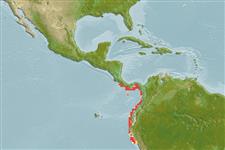>
Gadiformes (Cods) >
Macrouridae (Grenadiers or rattails)
Etymology: Coelorinchus: Greek, koilos = a hollow + Greek, rhyngchos = jaw (Ref. 45335).
More on author: Garman.
Environment: milieu / climate zone / depth range / distribution range
Ecología
marino bentopelágico; no migratorio; rango de profundidad 120 - 460 m (Ref. 9315). Tropical; 9°N - 9°S, 86°W - 77°W (Ref. 1371)
Eastern Pacific: Costa Rica to northern Peru.
Tamaño / Peso / Age
Maturity: Lm ? range ? - ? cm
Max length : 27.5 cm TL macho / no sexado; (Ref. 42942)
Short description
Morfología | Morfometría
Espinas dorsales (total): 0; Espinas anales 0. Head large; eyes large; snout moderately pointed, its anterolateral margin incompletely supported by bone. Head ridges rather weakly scaled, other head scales mostly without spinules; the dorsal and ventral snout surfaces mostly naked. Spines on lower jaw and pectoral girdle without spinules. Light organ large, lens-shaped black fossa between the pelvic fin bases. Swim bladder oval, with 6 to 11 short retia mirabilia and gas glands. Pyloric caeca 10 to 14. Overall color is light brown to swarthy, somewhat silvery ventrally, with heavy punctuations; mouth pale, blackish along tongue base; gill cavity blackish, paler with punctuations toward inner surfaces.
Juveniles are bathypelagic (Ref. 9315). Feeds mainly on copepods and other small crustaceans, but not exclusively bottom-dwelling invertebrates (Ref. 9315).
Life cycle and mating behavior
Madurez | Reproducción | Puesta | Huevos | Fecundidad | Larva
Cohen, D.M., T. Inada, T. Iwamoto and N. Scialabba, 1990. FAO species catalogue. Vol. 10. Gadiform fishes of the world (Order Gadiformes). An annotated and illustrated catalogue of cods, hakes, grenadiers and other gadiform fishes known to date. FAO Fish. Synop. 125(10). Rome: FAO. 442 p. (Ref. 1371)
IUCN Red List Status (Ref. 130435)
Threat to humans
Harmless
Human uses
Pesquerías: sin interés
Más información
Nombres comunesSinónimosMetabolismoDespredadoresEcotoxicologíaReproducciónMadurezPuestaAgregación para la puestaFecundidadHuevosEgg development
Age/SizeCrecimientoLength-weightLength-lengthLength-frequenciesMorfometríaMorfologíaLarvaDinámica larvariaReclutamientoAbundanciaBRUVS
ReferenciasAcuiculturaPerfil de acuiculturaRazasGenéticaElectrophoresesheritabilidadEnfermedadesProcesamientoNutrientsMass conversion
Herramientas
Special reports
Download XML
Fuentes de Internet
Estimates based on models
Preferred temperature (Ref.
123201): 13.1 - 14.7, mean 13.8 °C (based on 8 cells).
Phylogenetic diversity index (Ref.
82804): PD
50 = 0.5000 [Uniqueness, from 0.5 = low to 2.0 = high].
Bayesian length-weight: a=0.00251 (0.00128 - 0.00492), b=3.19 (3.03 - 3.35), in cm total length, based on LWR estimates for this Genus-body shape (Ref.
93245).
Nivel trófico (Ref.
69278): 3.2 ±0.33 se; based on food items.
Resiliencia (Ref.
120179): Bajo, población duplicada en un tiempo mínimo de 4.5-14 años (Preliminary K or Fecundity.).
Fishing Vulnerability (Ref.
59153): Low vulnerability (18 of 100).
